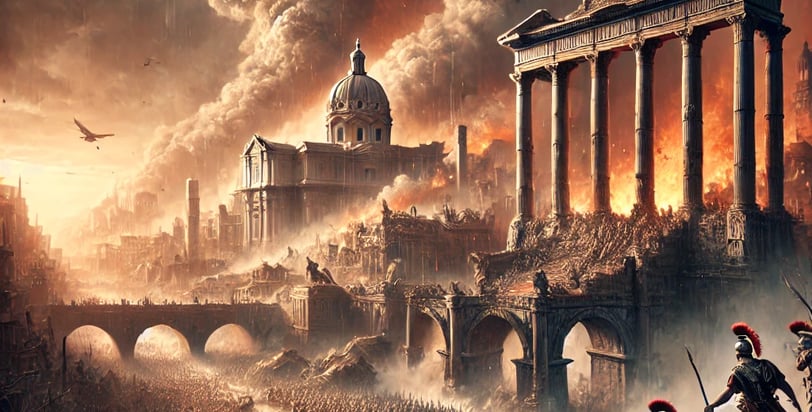"Why Did the Roman Empire Fall? 7 Key Reasons Behind History’s Greatest Collapse"
"Explore the political corruption, barbarian invasions, and economic collapse that led to Rome's downfall. Learn how ancient mistakes still shape modern empires!"


The Fall of the Roman Empire: How a Superpower Crumbled from Within
The Roman Empire, once the undisputed ruler of the ancient world, stretched from Britain to Egypt and symbolized unparalleled military might, cultural sophistication, and economic power. Yet, by 476 CE, the Western Roman Empire collapsed, leaving historians debating its downfall for centuries. In this blog, we explore the key factors behind Rome’s decline and how its legacy still echoes today.
1. Political Instability: The Rot at the Top
Rome’s political system devolved into chaos after the Pax Romana (27 BCE–180 CE). Frequent emperors assassinations, corruption, and the Praetorian Guard’s power to sell the throne destabilized governance. Over 20 emperors ruled in the 3rd century alone, many meeting violent ends. This “Crisis of the Third Century” eroded public trust and administrative efficiency, crippling the empire’s ability to respond to crises.
2. Economic Collapse: Inflation, Taxes, and Slavery
Rome’s economy relied on conquests and slave labor. When expansion stalled, resources dried up. Emperors like Nero debased silver coins, causing hyperinflation. Meanwhile, oppressive taxes burdened farmers and merchants, driving wealth inequality. The reliance on slaves stifled innovation, leaving Rome unprepared for economic shifts.
3. Military Overstretch: The Cost of Empire
At its peak, Rome’s borders spanned 2 million square miles. Maintaining legions across Europe and Asia drained the treasury. Mercenaries replaced citizen-soldiers, lacking loyalty to Rome. The defeat at the Battle of Adrianople (378 CE) by the Goths exposed military vulnerabilities, signaling the beginning of the end.
4. Barbarian Invasions: The Final Blow
External pressures mounted as Germanic tribes like the Visigoths and Vandals, fleeing the Huns, breached Rome’s borders. The sack of Rome by Alaric’s Visigoths in 410 CE and the Vandals in 455 CE shattered the empire’s invincibility. Without military or economic strength, Rome could no longer defend itself.
5. Social Decay: A Society Losing Its Way
Roman values like disciplina (discipline) and civic duty faded as luxury and decadence spread. The elite prioritized personal gain over public service, while the poor grew reliant on “bread and circuses.” Some historians argue Christianity’s rise undermined traditional Roman identity, though this remains debated.
6. Division of the Empire: East vs. West
Emperor Diocletian’s split of the empire into Eastern and Western halves in 285 CE aimed to simplify governance. However, the West, lacking the East’s trade wealth, struggled to survive. While the Byzantine Empire (East) thrived until 1453, the West collapsed under weak leadership and external threats.
7. Environmental Factors: Climate and Disease
Recent studies suggest climate change and pandemics accelerated Rome’s fall. The Antonine Plague (165–180 CE) and Plague of Cyprian (249–262 CE) killed millions, destabilizing society. Deforestation and soil depletion also reduced agricultural output.
Lessons from Rome’s Fall: Why It Matters Today
The Roman Empire’s collapse wasn’t due to a single cause but a “perfect storm” of political, economic, and social failures. Modern nations can learn from Rome’s mistakes: unchecked corruption, unsustainable growth, and societal division can doom even the mightiest powers.
FAQ Section
Q: When did the Roman Empire officially fall?
A: The Western Roman Empire fell in 476 CE when Odoacer deposed Emperor Romulus Augustulus.
Q: Did Christianity cause Rome’s fall?
A: No—it was one of many factors. Edward Gibbon popularized this theory, but modern historians emphasize systemic issues.
Q: What survived Rome’s collapse?
A: Roman law, architecture, and language (Latin) influenced Europe’s development. The Byzantine Empire preserved Roman traditions until 1453.
